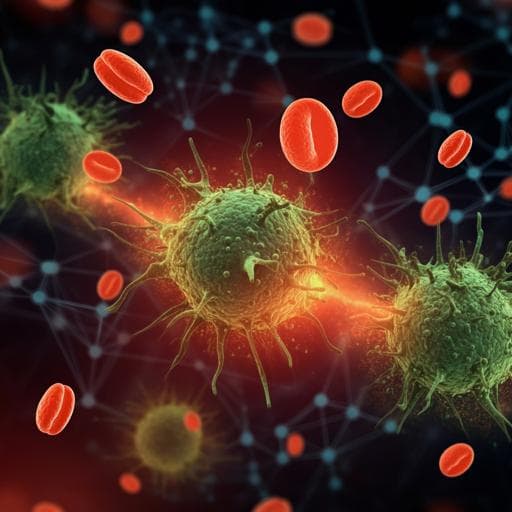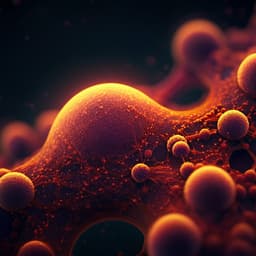
Medicine and Health
Oncolytic viruses engineered to enforce cholesterol efflux restore tumor-associated macrophage phagocytosis and anti-tumor immunity in glioblastoma
S. Wang, W. Yan, et al.
This groundbreaking research by Shiqun Wang, Wei Yan, and colleagues reveals how cholesterol metabolism in glioblastoma impairs antitumor immunity, leading to disease progression. By harnessing apolipoprotein A1, they not only restore phagocytosis in tumor-associated macrophages but also activate a long-lasting immune response, offering a potential immunometabolic therapy for this aggressive cancer.
~3 min • Beginner • English
Introduction
The study addresses how glioblastoma (GBM) metabolic codependency on cholesterol uptake shapes the tumor microenvironment (TME) and suppresses antitumor immunity, particularly by impairing tumor-associated macrophage (TAM) phagocytosis. Non-oncogene addiction (codependence) can arise from altered biochemical environments; in GBM, the brain’s unique cholesterol biology is central, as the brain contains about 20% of body cholesterol and relies on astrocyte synthesis due to the blood–brain barrier. GBM cells depend on exogenous cholesterol uptake and are sensitive to modulators that limit LDLR-mediated intake or promote efflux (e.g., LXR-β agonist LXR-623), though clinical CNS toxicity has limited translation. Cholesterol homeostasis also impacts immune cells: high cholesterol can exhaust CD8 T cells and influence macrophage tolerance. The authors hypothesize that GBM’s cholesterol-rich TME drives TAM phagocytic fragility via upregulation of “don’t eat me” receptors, and that enhancing cholesterol efflux with ApoA1 could restore TAM function and reinvigorate TAM–T-cell antitumor responses. They further propose delivering APOA1 via an oncolytic adenovirus to reprogram the TME and test efficacy and safety in preclinical models.
Literature Review
Prior work shows GBM relies on exogenous cholesterol uptake with elevated EGFR/LDLR signaling and reduced de novo synthesis (SREBP2), creating a metabolic codependency. LXR-623 promotes ABCA1/G1-mediated efflux and reduces LDLR uptake but caused adverse CNS events clinically. Cholesterol accumulation in T cells can induce exhaustion and signaling defects; macrophage cholesterol perturbations can drive immunosuppression, though context-dependent studies report both cholesterol efflux-associated M2 phenotypes and synthesis inhibition favoring M1 polarization. Blocking phagocytosis checkpoints like PD-1, CD47/SIRPα, and CD24/Siglec-10 can enhance macrophage antitumor activity in GBM models, but systemic blockade may cause toxicity (e.g., anemia, thrombocytopenia). Oxysterols such as 7-ketocholesterol are known to damage mitochondria and affect macrophage function. These findings motivate an approach targeting TAM cholesterol efflux to modulate immunity within the GBM TME.
Methodology
- Models: Orthotopic GBM models in mice and rats (human U251-MG in Balb/c nude mice, murine GL261 in C57BL/6J mice, rat C6 in SD rats; also murine G422 in KM mice). Immune-reconstituted humanized GBM model (U138-MG in NCG mice with human PBMCs). Mostly male animals were used.
- TME cholesterol profiling: Quantified total cholesterol in fresh tissues (brain, tumor, spleen) and interstitial fluids (BIF, TIF) using Amplex Red assays; fractionated HDL-like vs LDL/VLDL cholesterol in TIF. Assessed ApoE distribution by immunostaining. Analyzed human TCGA-GBM vs normal brain for cholesterol uptake/synthesis gene expression (GEPIA2).
- Immune subset cholesterol and function: Flow cytometry with Filipin III staining measured cholesterol in tumor cells, microglia, monocytes, TAMs, and lymphocytes. TEM characterized TAM ultrastructure. Assessed phagocytosis ex vivo using NBD-cholesterol-labeled tumor debris, heat-inactivated S. aureus, and fluorescent tumor cells (GL261YFP/T98GGFP). In vivo phagocytosis measured by YFP+ TAMs in orthotopic tumors.
- TAM receptor profiling: Measured uptake receptors (LDLR, CD36, CD64) and inhibitory receptors (SIRP-α, Siglec-10, PD-1) on TAMs vs peripheral macrophages. Manipulated cholesterol in vitro (loading or β-cyclodextrin depletion) and tracked receptor expression. Adoptive transfer of CD45.1 BMDMs (vehicle vs cholesterol-loaded) into GL261-bearing CD45.2 mice to assess in vivo cholesterol accumulation, inhibitory receptor upregulation, and phagocytosis.
- ApoA1 interventions: Examined APOA1 and ABCA1/G1 expression in tumors and immune subsets; tested ApoA1 effects on GBM cell proliferation in vitro. Generated GBM cell lines stably expressing APOAI (GL261APOAI, G422APOAI) and compared to controls in immunocompetent and immunodeficient mice. Measured TIF cholesterol. Immune depletion (anti-CD8, anti-CD4, anti-NK1.1, clodronate liposomes/anti-CSF1R) to define cell requirements. Coculture killing assays with TAMs, OT-1 CD8+ T cells, and GL261OVA-Luc; assessed TAM–T-cell contacts and CD8 T-cell proliferation with/without direct contact.
- Mechanism studies: RNA-seq of TAMs from GL261APOAI vs control; cholesterol-targeted metabolomics of TAMs (LC/MS) to quantify cholesterol and oxysterols (e.g., 7-ketocholesterol). Assessed ER stress (XBP1s). Evaluated mitochondrial RNA metabolism gene expression, mitochondrial protein content (SDS-PAGE/silver staining), activity (MitoTracker), membrane potential (JC-1), morphology (TEM), and mitophagy after cholesterol/7K-Cho exposure. Tested ABCA1 inhibitor (DIDS) effects on cholesterol efflux and phagocytosis; TNF pathway luciferase reporters in THP-1 macrophages; TNF-α inhibitor (CC5013) rescue/abrogation of ApoA1-induced phagocytosis.
- Oncolytic adenovirus engineering: Constructed AdVAPOAI (E1A-competent Ad5) vs AdVCtrl, validated ApoA1 expression in 293T cells, tumor selectivity via CAR-expressing GBM cells (GL261CAR, G422CAR). Intratumoral dosing in orthotopic models; monitored tumor growth (IVIS), survival, body weight, immune infiltration (flow cytometry), PD-L1, CD8 T-cell activation/exhaustion markers, and RNA-seq of tumor bulks (DEGs, KEGG/GO). Bilateral subcutaneous GBM model to test abscopal/systemic effects and viral shedding.
- Safety: Compared ApoA1 vs LXR-623 toxicity in neural stem cells in vitro. Evaluated histopathology in mice (brain, heart, lung) after APOAI expression or adenoviral treatment. Long-term toxicity study of intracranial AdVAPOAI in mice (antiviral antibodies, cytokines, biodistribution, shedding, histopathology) and maximum exposure study in rhesus monkeys (s.c./i.v. dosing; clinical signs, pathology).
- Statistics: Mann–Whitney, paired/unpaired t tests, one-/two-way ANOVA, log-rank tests; RNA-seq analyses in R; significance at P<0.05.
Key Findings
- Cholesterol distribution: Tumor tissue cholesterol (4.97–5.69 μg/mg) was higher than spleen (0.81–1.20) but lower than normal brain (6.56–7.27). TIF cholesterol (0.37–0.54 μg/mg tissue) exceeded BIF (0.05–0.10), indicating extracellular cholesterol pooling in GBM TME. HDL-like cholesterol in TIF (0.29–0.39) far exceeded LDL/VLDL (0.03–0.05). ApoE accumulated at tumor margins in murine and patient GBM; GBM expressed higher EGFR/LDLR and lower SREBP2 vs normal brain.
- TAM cholesterol and phagocytosis: TAMs harbored markedly elevated cholesterol versus tumor-infiltrating monocytes (3.17-fold) and peripheral macrophages (2.0–2.6-fold), with increasing monocyte-derived TAM prevalence during progression. TAMs displayed foamy phagosomes with uncleared debris and nuclear heterochromatin. Phagocytic uptake of cholesterol-labeled debris and microbes was impaired by TIF or cholesterol loading and in vivo after transferring cholesterol-loaded BMDMs.
- “Don’t eat me” receptors: Despite high CD36/CD64, TAMs upregulated Siglec-10 and PD-1 (but had lower SIRP-α than periphery). Cholesterol accumulation increased Siglec-10/PD-1; cholesterol depletion reduced them. Infiltrating BMDMs in tumors gained cholesterol and upregulated these receptors versus spleen.
- ApoA1 restores TAM function via efflux: APOAI expression was low in GBM cells; ABCA1/G1 was highly upregulated in tumor-infiltrating immune cells, especially TAMs (~17-fold vs peripheral macrophages). ApoA1 reduced TAM cholesterol more than T-cell cholesterol and increased cholesterol efflux (partially blocked by ABCA1 inhibitor DIDS). ApoA1 enhanced TAM phagocytosis ex vivo/in vivo and decreased Filipinhigh/Siglec-10high and Filipinhigh/PD-1high TAMs.
- Macrophage–T-cell codependency: APOAI-expressing GBMs prolonged survival only in immunocompetent mice; macrophage or CD8 T-cell depletion abrogated benefit. ApoA1 increased MHC-I/II expression on TAMs, strengthened TAM–CD8 T-cell contacts, boosted CD8 T-cell proliferation only with TAM and tumor cell contact, increased IFN-γ/TNF-α+ CD8 TILs, and reduced PD-1+/LAG-3+ exhausted CD8 T cells.
- Mechanism—7-ketocholesterol and mitochondria/TNF axis: ApoA1 reprogrammed TAM lipid metabolism, reducing cholesterol and oxysterols (notably 7-ketocholesterol). Cholesterol/TIF downregulated mitochondrial RNA metabolism genes; 7K-Cho reduced mitochondrial proteins (10–35 kDa range), damaged mitochondrial structure, and decreased membrane potential, increasing mitophagy. RNA-seq of BMDMs treated with 7K-Cho or doxycycline (mitochondrial translation inhibitor) enriched TNF signaling disruption. Cholesterol/7K-Cho suppressed TNF-α production and TNF-induced NF-κB activation (without affecting IL-6/STAT3). ApoA1’s phagocytosis rescue required TNF signaling and was impaired by TNF-α inhibition or excess 7K-Cho.
- Oncolytic AdVAPOAI therapy: AdVAPOAI replicated in tumors, secreted ApoA1, and retained oncolytic potency. Intratumoral AdVAPOAI suppressed tumor growth, prolonged survival, and maintained body weight in GL261CAR and G422CAR models; complete response rate 42% (GL261CAR). In humanized U138-MG model, AdVAPOAI inhibited tumors with 71% complete responses. AdVAPOAI increased TILs, boosted CD8 T-cell activation (CD44, IFN-γ, granzyme B), and reduced exhaustion markers (PD-1, LAG-3, TIGIT). Tumor bulk RNA-seq showed downregulated lipid metabolism and upregulated phagocytosis genes. TAMs from AdVAPOAI-treated tumors had lower PD-1 and higher MHC-II; increased lymphocyte:tumor cell ratios.
- Systemic immunity: In bilateral GBM, unilateral AdVAPOAI caused tumor control on both injected and contralateral sides, associated with increased CD8 TILs and not viral shedding. Depletion of CD8 T cells or macrophages abrogated efficacy. Cured mice exhibited tumor-specific memory responses and resisted rechallenge (intracranial and subcutaneous GL261), with increased CD8 memory subsets.
- Safety: ApoA1 was non-toxic to neural stem cells in vitro versus LXR-623. In mice, intracranial AdVAPOAI showed manageable, resolving histopathology; antiviral antibodies rose after repeat dosing with minimal cytokine elevation (slight IFN-γ). In rhesus monkeys, high-dose s.c. exposure (1.5×10^12 VP/kg) caused 10% severe toxicity (STD10) with reversible liver lesions in survivors; overall lesions recovered over 4 weeks.
Discussion
The findings demonstrate that GBM’s dependence on exogenous cholesterol establishes a cholesterol-rich TME that loads TAMs with cholesterol, upregulates phagocytosis-inhibitory receptors (Siglec-10, PD-1), and provokes phagocytic fragility. Cholesterol’s toxic metabolite 7-ketocholesterol impairs mitochondrial translation and TNF signaling in macrophages, providing a mechanistic link to defective phagocytosis. Enforcing cholesterol efflux with ApoA1 focuses on TAMs (high ABCA1/G1) to reduce intracellular cholesterol/oxysterols, restore mitochondrial integrity, relieve checkpoint receptor expression, and reinvigorate phagocytosis and antigen presentation. This reprogramming enables productive TAM–CD8 T-cell crosstalk, enhancing T-cell proliferation and effector function and reducing exhaustion phenotypes, thereby converting the GBM TME to an immune-permissive state. Delivering APOA1 via an oncolytic adenovirus creates local efflux, complements oncolysis, remodels lipid metabolism transcriptionally, and initiates systemic antitumor immunity with durable memory, addressing limitations of prior cholesterol-targeting agents (e.g., LXR-623 CNS toxicity) by sparing neuronal cholesterol homeostasis.
Conclusion
This work identifies cholesterol-driven TAM phagocytic fragility as a key immunosuppressive mechanism in GBM and reveals 7-ketocholesterol–mediated mitochondrial translational inhibition/TNF signaling disruption as a central pathway. Enforcing cholesterol efflux with ApoA1 restores TAM phagocytosis, enhances antigen presentation, and activates a TAM–CD8 T-cell axis that clears tumors and establishes long-term, tumor-specific immune memory. An ApoA1-armed oncolytic adenovirus achieves potent intratumoral reprogramming, systemic antitumor responses, high complete response rates, and an acceptable safety profile in preclinical models. These findings support immunometabolic therapies targeting TAM cholesterol efflux and provide a translational platform to combine metabolic reprogramming with oncolytic virotherapy. Future studies should dissect molecular details of 7-ketocholesterol’s impact on mitochondrial translation and explore clinical translation and combinatorial regimens (e.g., checkpoint blockade).
Limitations
The study was primarily conducted in male murine and rat models and preclinical humanized systems, which may limit generalizability to diverse patient populations. While 7-ketocholesterol was implicated in disrupting TAM mitochondrial translation and TNF signaling, the precise molecular mechanisms remain to be fully elucidated. Oncolytic adenovirus safety, although encouraging in animals, requires careful evaluation in humans; high-dose systemic exposure in nonhuman primates revealed toxicity that mandates dose and route optimization.
Related Publications
Explore these studies to deepen your understanding of the subject.







